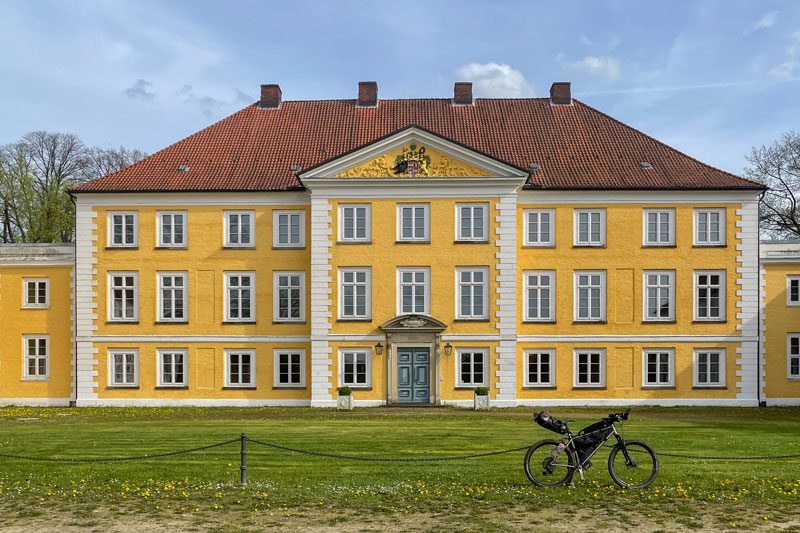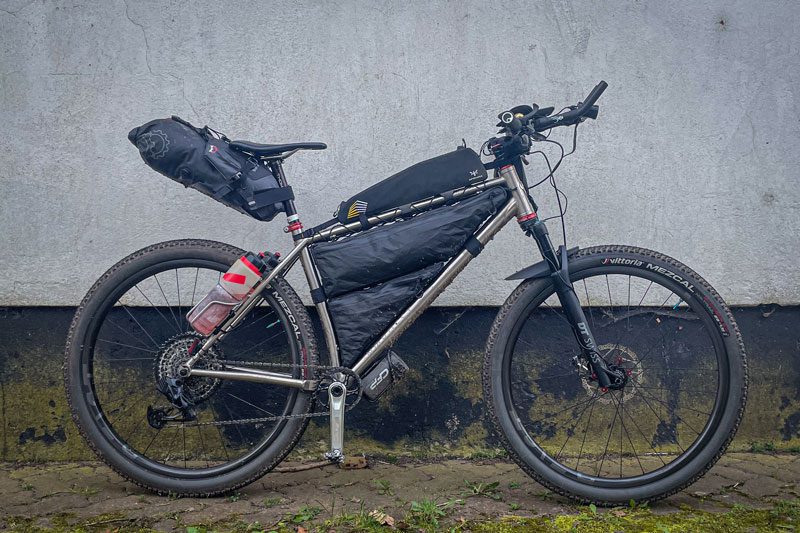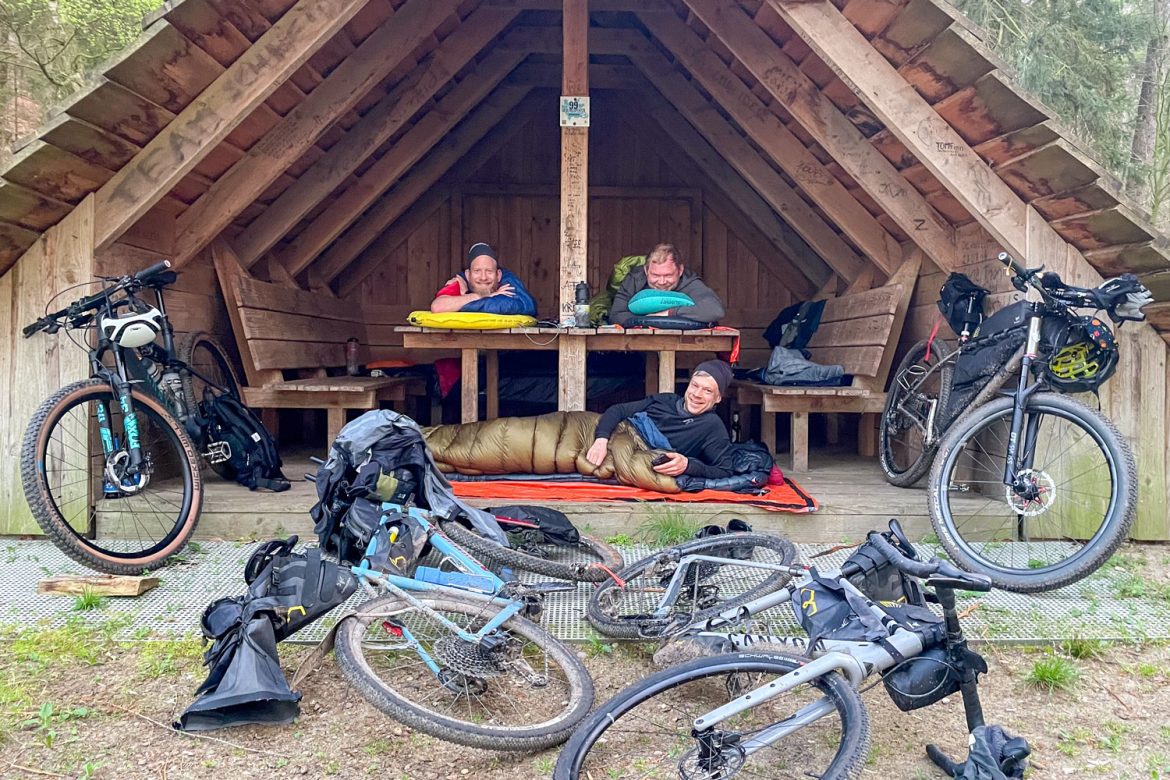I was really looking forward to this: finally getting out with my bike and luggage for almost two days, switching off and enjoying nature. The days and weeks leading up to it had been very demanding at work, so I was glad to finally be able to concentrate on the simple things again.
The reason for this overnighter was an appointment with Nils and Gunnar, as we wanted to meet up again anyway and then cycle a section of the Hackenpedder route from Lauenburg on the Elbe up to Lübeck the next day. Nils had organised a group ride for this, which 20 people followed the next day.

It was also a great opportunity for me to try out my new bike and set-up for the Trans Balkan Race.
And we can start with that. I packed my new Nordest MTB the way I would ride through the Balkans: I put my sleeping gear in the back, the bivy sack and small items in the new frame bag, a food pouch for snacks in the front and I borrowed a long Apidura top tube bag from Nils for the top.
It contained small items such as a wallet, tissues, bars and nose spray. I didn’t bring the hydration pack I’m planning to use for the race. I also need some space for rain gear, but that should fit. My tools were stowed on the down tube. The bottles in the back were ok. But I’m thinking about taking the 750ml bottles instead of the 950ml. If you get out of the saddle and go backwards on a descent, I occasionally hit it with my leg. Not bad, but it doesn’t have to be. I’m not going to fit them to the front of the fork.

Maybe I’ll rebuild the whole thing again and move the sleeping gear to the front of the handlebars and just use a small race saddlebag from Restrap at the back. I’ve given the Apidura back to Nils and bought the long Cyclite top tube bag, which I was also impressed with in the test. And it can be retrofitted with eyelets for mounting on the top tube, which I’m going to do.

I was also able to try out my Sinewave light as we were riding in the dark. It produces a very nice light, illuminates well and the integrated USB charger works perfectly.
It was also important for me to see how the new bike behaves and moves when loaded. As expected, it remains agile enough and rides wonderfully fast. I was impressed with how well it handles off-road and how well it performs on long-distance rides. I’m also impressed with the suspension fork, which I switched depending on the surface.
All in all, a very positive and convincing experience. I’m going to lower the stem by another 3mm to take some more pressure off the shoulders, but that’s it. And as far as my bum is concerned: if I ride at a normal rhythm and pace, the strain is normal. I then tried Gunnar’s “2nd Skin” cream, which covers everything like silicone. It’s quite expensive and you can buy it mainly in sex shops, but it’s good!
Saddle and new trousers fit well together and with a bit of care it should be fine.

And so I rolled happily and with a little tailwind and sunshine towards Großensee, in the east behind Hamburg, where I wanted to meet Nils and Gunnar. The two of them had started in the rain in Kiel in the morning and already had a few kilometres in their legs. Our meeting point was the Italian restaurant “Picolo”, but it was less Mediterranean than I had expected. So we just had a quick ice cream and a Coke and quickly rolled on southwards on the Hackenpedder route towards the Elbe. There, near Lauenburg, Nils had found a shelter, a large hut in the forest, where we planned to set up camp.

On the way, we were joined by Alex, who suddenly appeared in the thicket behind us. With his fully, he was of course perfectly equipped for the track. However, the Hackenpedder route is also easy to ride on a gravel bike, even if there are a few sections that were churned up by wild boar, for example, or where it goes over roots, through sand and on smaller tracks, where an MTB isn’t bad either.

Once we arrived at the Elbe, we took a short break, ate something and then rolled into the forest and to the shelter in warm temperatures. This shelter really was a bikepacking dream: nice and big and beautifully situated. With a view of the Elbe (if it’s not too dark) and quite clean. We ended the day with non-alcoholic beer and snacks, recorded a podcast before making ourselves comfortable on the table, the bench and in front of the hut and going to sleep.
At 21 degrees, one of the warmest days of the year so far awaited us the next morning as we rolled out of our sleeping bags and onto our bikes. Our first stop was a supermarket bakery in Lauenburg before we set off for the official meeting point of the Hackenpedder group ride at the triangle of Lower Saxony, Schleswig-Holstein and Mecklenburg-Western Pomerania.

20 people responded to Nils’ call and together we set off to explore the Hackenpedder section from Lauenburg to Lübeck. Parts of the route were familiar, others were new.
Right at the start, there were a few crisp but short climbs. By then we were all awake and a little later we were able to see the border towers of the former inner-German border on the Elbe. I was always impressed by how close the border was to Hamburg.

The old border accompanied us all the way along this section of the Hackenpedder. The landscape became more and more heath. We reached the former death strip and stopped at the memorial to Michael Gartenschläger, who was shot here by GDR border guards.



Although the road was a little sandy, it was very easy to ride. We made rapid progress and worked our way through the undergrowth and along country lanes to Zarrentin. Here I said goodbye and turned west to ride another 90 kilometres against the wind back to Hamburg.

This was easier than I had feared and my track led through the forest along the motorway. Unfortunately, I had loaded the wrong track, which meant I was suddenly in the centre of Hamburg instead of heading further north to avoid the chaos.

But that didn’t matter, because at the end of the day I had 160 kilometres behind me on the new bike, which was a very good test.

In any case, the Hackenpedder is a really nice route – not too demanding, but definitely with small challenges. If you fancy taking a look at the 600 or 1,000 kilometres yourself, or even just parts of it, you can find all the information you need here:





